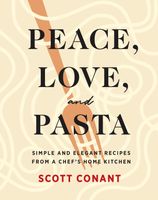Label
All
0
Clear all filters
Prue Leith's latest book is now on ckbk. Get 25% off ckbk Membership
Pasta and Gnocchi Dough
Appears in
By Scott Conant
Published 2021
Making fresh pasta dough takes a little bit of getting used to, but it’s such a rewarding skill for a home cook to have in their repertoire. Here are a couple of tips to set you up for success:
- Make your dough well in advance, at least a day ahead of when you plan to use it. (With the exception of the gnocchi and gnudi, which you can cook right away.) Letting your dough rest before you shape it will make it easier to work with; I also freeze shaped pasta such as the cavatelli after the shapes have been cut, because if you cook it when it’s too fresh, the pieces swell up.
- If possible, try to weigh the flour in grams, rather than measuring it in cups. It’s more accurate.
- Be specific about flour selection. Different flours have different protein compositions and gluten strengths, which affects the texture of the finished pasta. Double zero (00) flour and semolina are the most common flours used in pasta making. (In Italy, the number refers to the coarseness of the grind, with 00 being the most finely ground, and 2 being the coarsest.) These flours are readily available online, in specialty markets, and even at some supermarket chains. Seek them out, and avoid substituting all-purpose flour if possible.
- Test cook your dough before you shape it all, especially for dumplings like the gnocchi and gnudi, to make sure the pasta doesn’t fall apart in the water. Years ago, William Grimes, who was the restaurant critic for the New York Times then, walked into a restaurant I was working in and ordered gnocchi. Turns out the guy at the pasta station hadn’t tested it, so you can imagine my horror when the gnocchi fell apart in the cooking water. We had to cook each piece with a slotted spoon very, very carefully to make sure the critic got presentable-looking gnocchi. Learn from my mistakes.
Become a Premium Member to access this page
Unlimited, ad-free access to hundreds of the world’s best cookbooks
Over 150,000 recipes with thousands more added every month
Recommended by leading chefs and food writers
Powerful search filters to match your tastes
Create collections and add reviews or private notes to any recipe
Swipe to browse each cookbook from cover-to-cover
Manage your subscription via the My Membership page
Best value
Part of
Advertisement
Related Recipes
-
-
-
-
Related Reference
-
-
-
-
Advertisement
The licensor does not allow printing of this title



